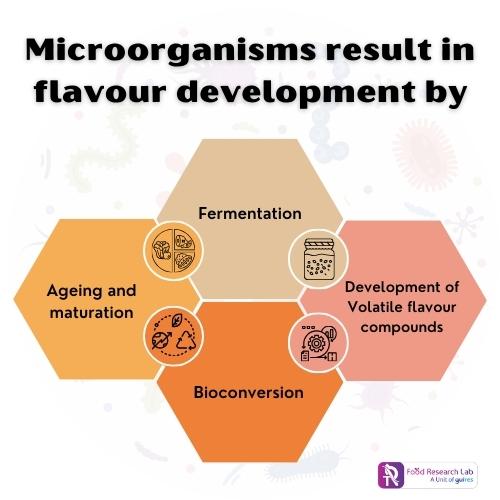
Microorganisms & Food Flavor Development
How do microorganisms contribute to food flavour development?
The shift towards natural flavours
- Flavour plays a crucial role in our everyday lives and is present in food products, beverages, dietary supplements, and cosmetics.
- Examples of flavoured food and beverage products include flavoured mineral water, alcoholic beverages, flavoured milk and cola flavoured gummies.
- Flavour development is a complex process since it depends on using many ingredients for developing a product and how our sensory perception of the ingredients provides the overall flavour experience.
- Artificial flavours have been used for many years since they are relatively more economical. However, they are associated with adverse effects like allergy, headaches, nausea, and hyperactivity in children.
- In the long term, artificial flavours can cause kidney and brain damage and respiratory depression. In addition, artificial flavours are also linked to the causation of certain types of cancers.
- The increasing consumer awareness has led them to seek natural alternatives to artificial flavours.
Microorganisms for food flavour development
- Natural flavouring compounds in food, beverages and dietary supplements are used from plant extracts like plant essential oils. Sourcing from plants may be resource and time-intensive.
- Some advances have been made in addressing the drawbacks of flavour development from plants, such as culturing plant cells.
- Biotechnological advances have made it possible to synthesise flavour even more economically using enzymes. Microorganisms are relatively easy to culture and can produce flavours de novo. The subsequent section will elaborate on the mechanism of food flavour development.
Mechanism of microorganisms for food flavour development
Microorganisms contribute to flavour development by the following mechanisms:

- Fermentation
- Microorganisms such as bacteria and yeast are frequently used in fermentation to convert ingredients into finished product. They digest complex carbohydrates, proteins, and lipids into simpler components, producing a diverse range of flavour compounds as metabolic by-products.
- Lactic acid bacteria, for example, convert lactose into lactic acid during the fermentation of dairy products such as yoghurt and cheese, which gives rise to the tangy flavour.
- Development of volatile flavour compounds
- During their metabolic processes, microorganisms can produce volatile compounds like esters, aldehydes, and ketones.
- These volatile compounds have distinctive aromas and flavours that significantly impact the sensory perception of food. For example, yeasts contribute to the distinct flavour of bread and alcoholic beverages.
- Bioconversion
- Microorganisms facilitate the conversion of intermediate products or added precursors by a process called bioconversion. Examples of bioconversion include flavour compounds like terpenes, wherein the microorganisms break them down to develop substances with added value.
- An example is the conversion of sesquiterpene valencene, a component of orange oil, into sesquiterpene nootkatone, an important aroma compound of grapefruit.
- Flavour development by ageing and maturation process
- Microorganisms can aid in flavour development during ageing and maturation processes. This is especially noticeable in foods such as cured meats, wines, and cheese, where the action of specific microbes over time results in the production of complex and desirable flavours [1].
Conclusion
Advances in biotechnology have led to the innovation in natural flavour development. Microorganisms have been widely studied for this purpose. They are simple to grow and can develop flavour development by various methods that include fermentation, development of volatile flavour compounds, bioconversion and ageing and maturation process. Flavours created by microorganisms can be used for fermented dairy products, alcoholic beverages, baked goods and dietary supplements, like chocolate flavoured whey protein shots.
How the Food Research Lab can help
We are a team of food scientists and technologists who offer new product development services for food and beverage start-ups. Our global contract R&D facility enables the development of a wide range of food and beverage products using the most efficient technologies. We also abide by regulatory guidelines, such as Good Manufacturing Practices and ensure that we deliver only high-quality products with excellent sensory and flavour profiles, guaranteeing their success.





